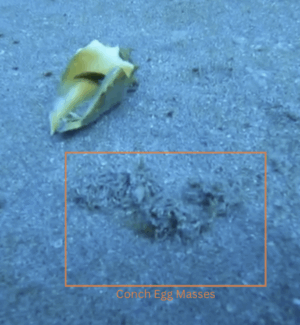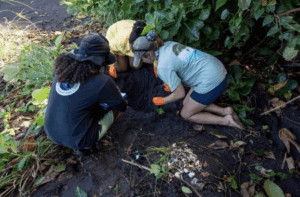Conservation Collective visits St Vincent and the Grenadines Environment Fund
Since 2022, St Vincent and the Grenadines Environment Fund (SVGEF) has been working with Blue Marine Foundation, the St Vincent and the Grenadines Fisheries Service, and the local fisherfolk of the island of Bequia to monitor Queen conch (Lobatus gigas) populations – known to be in decline due to overharvesting – and designate Marine Protected Areas around their nursing and breeding spots.
This year, I (Berta Manzano, Programme Manager) joined their teams for three days of dive surveys, which confirmed the existence of wild queen conch nurseries (i.e., with an abundance of juvenile individuals) in the areas of Isle A Quatre and Adams Bay. What was even more exciting was the identification of queen conch egg masses very near the Bequia harbour, something that had never been recorded on camera in St Vincent and the Grenadines!


As a result of the surveys and a consultation workshop with the local fishers of Bequia, the following conservation measures have been presented to the incumbent SVG Fisheries Minister, Mr Saboto Caesar, the SVG Chief Fisheries Officer, and relevant members of the opposition party, New Democratic Party:
- An official seasonal moratorium on the harvesting of conch between September and November. This was presented in 2023 but has not been implemented yet.
- The establishment of two Marine Protected Areas in Bequia using the queen conch as the umbrella species for their enforcement.
- The piloting with the Bequia fisherfolk of a protection measure for the Spiny Caribbean lobster, referred to as V-Notching. V-notching implies the physical marking (with a harmless cut on the tail) of large egg-bearing female lobsters when captured by fishers and their being returned at sea. If followed correctly, this initiative ensures that lobsters with such a marking are never captured and/or consumed, thus allowing for population recovery.
After the field work in Bequia we returned to St Vincent, where we were joined by Issa Gonzalez-Peltier, the Executive Director of Antigua and Barbuda Environment Foundation.
Stephan Hornsey and Lisa Gaymes, from SVGEF, took us to prominent sea turtle nesting beaches on the island, where local rangers funded and trained via the CC partnership with Edmiston identified green turtle nesting activity for the first time in that part of the island (Windward coast). During one of our patrols, we came across three nests (two from green turtles and one from a hawksbill turtle) that had recently hatched with a success rate of over 90%! The team also emphasised the importance of the recently purchased thermal scope, which allows rangers to spot poachers and threats to nesting turtles from a distance, ensuring any deterrence action is carried out safely.

Another extremely interesting part of this trip was the conversation SVGEF facilitated with Mr Samuel Hazelwood, Chief whaler of the Barrouille community, with whom last year SVGEF agreed the ban on hunting orcas and bottlenose dolphins. It is undeniable that there is still a lot of work to be done regarding whaling practices in St Vincent and the Grenadines but SGVEF’s approach to working with whalers towards alternative income streams, rather than against them, will ensure long-lasting benefits for everyone on this incredibly complex field.
All in all, this was a wonderfully enlightening experience, where Conservation Collective was able to see first-hand the amazing (and challenging) work SVGEF and its local and international partners are spearheading. We are forever grateful to everyone who made this trip possible!